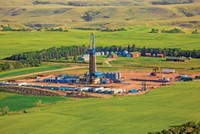Advertisement
Grab your lab coat. Let's get started
Welcome!
Welcome!
Create an account below to get 6 C&EN articles per month, receive newsletters and more - all free.
It seems this is your first time logging in online. Please enter the following information to continue.
As an ACS member you automatically get access to this site. All we need is few more details to create your reading experience.
Not you? Sign in with a different account.
Not you? Sign in with a different account.
ERROR 1
ERROR 1
ERROR 2
ERROR 2
ERROR 2
ERROR 2
ERROR 2
Password and Confirm password must match.
If you have an ACS member number, please enter it here so we can link this account to your membership. (optional)
ERROR 2
ACS values your privacy. By submitting your information, you are gaining access to C&EN and subscribing to our weekly newsletter. We use the information you provide to make your reading experience better, and we will never sell your data to third party members.
Business
Back To The Well
Chemistry targets cost-efficient extraction of oil and gas from mature reserves
by Rick Mullin
November 20, 2006
| A version of this story appeared in
Volume 84, Issue 47

COVER STORY
Back To The Well
Events ranging from the natural to the political converged this year to boost the price of oil and gas to new highs. Hurricane Katrina and the wars in Iraq and Lebanon registered at the gas pump in 2006, as did long-term systemic pressures. The steady rise in energy consumption in countries such as China and India and the limited capacity of current reserves to meet the growing demand indicate that prices are likely to remain high.
Energy conservation and a push to develop alternative power sources—the major responses to the 1970s oil embargo—are again at the forefront of energy policy and technology development. But a more immediate response is occurring in oil and gas fields, where high fuel prices have sparked renewed interest in using enhanced oil-recovery (EOR) techniques on mature wells and even on abandoned, or brownfield, wells.
The effort to boost oil and gas extraction poses a range of technical and environmental challenges that, in turn, boost demand for oil-field chemicals. This broad category of products for drilling and maintaining wells has developed into a major growth patch for specialty chemicals such as surfactants, lubricants, and biocides. Several companies have made a serious push into this service-intensive market in recent years.
The Freedonia Group consulting firm projects that demand for formulated oil-field chemicals in the U.S. will increase 5.4% annually through 2009 to $5.2 billion. Among the main oil-field chemical categories of drilling fluids, completion fluids, and production chemicals, Freedonia sees the greatest opportunity for growth in drilling fluids, as producers push to tap more oil and gas from existing reserves.
Oil industry experts estimate that only about 30% of available oil and gas has been extracted from most existing wells. The cost of accessing additional reserves is prohibitive under normal circumstances. Today's circumstances are not normal, however, and the oil and gas industry is scrambling to extract the next increment.
"Oil is going to be a lot more difficult to produce," says Stephen Taylor, vice president for upstream operations at Nalco. "The easy oil is gone, as they say. We are going to be going to more difficult geographies and more difficult production channels." Among the latter are tar sands and oil shale deposits in Canada and the Rocky Mountain states. These represent a vast, but difficult to extract, quantity of hydrocarbons with unique processing requirements.
Custom development of chemicals for oil producers has become a major engine of growth for specialty chemical companies, Taylor says. "Innovation is directed at how you produce more oil, stimulate wells, and allow wells to work more efficiently," he says. "There is a lot of known oil, but the economics to produce it are marginal, even at high crude oil prices. If we can design chemistry that reduces capital investment to produce oil and gas from those fields, then operators who own those licenses can develop that crude."
Unlike Nalco and Baker Petrolite, which together, according to Taylor, represent about 50% of the oil-field chemicals market, most specialty suppliers do not deal directly with energy companies. Rather, they supply oil-field service firms such as Halliburton, Schlumberger, and BJ Services, which in turn tailor chemical supply to customers in the field.
According to Jim Prestidge, vice president of production enhancement in Halliburton's energy services group, the service industry's main concerns regarding chemicals include cost, supply-chain reliability, and environmental performance. Innovation is another key focus. "Halliburton is continuously looking for and developing proprietary technologies to address enhanced oil-recovery techniques and make wells more productive," Prestidge says.
Halliburton recently introduced a line of stimulation chemicals called GasPerm 1000, which is based on a new microemulsion surfactant that removes water drawn into drilling formations during the rock-fracturing process.
M-I Swaco, a joint venture of Schlumberger and drilling machinery supplier Smith International, relies on its chemical suppliers for basic product development, according to James E. Friedheim, director of fluids research and development. "We used to have a chemical manufacturing plant in Texas that did some very basic stuff, and we sold that off, figuring we would just depend on our suppliers to do our basic research," he says. "But our chemists work with them."
According to Friedheim, drilling fluids are new territory for a lot of the specialty chemical companies that have been drawn into the field by the upturn in drilling activity. Most of these firms currently supply production chemicals such as the proppants, which prop open fractures in rock, and surfactants used to keep wells productive. "They can get their hands around oil-field production chemicals," he says. "But they can't get their hands around drilling fluids. We need to educate them."
Friedheim and his competitors need highly customized chemistry. "You can't just walk in the door and say, 'You need emulsifiers? Well, take these emulsifiers,'" he says. "We often need emulsifiers for five different base oils with five different solvency factors."
Rather than get frustrated with the level of hand-holding needed in product development, Friedheim says he is encouraged that new suppliers are willing to get started. "In the past, probably our better luck has been with the midsized specialty manufacturers that can modify their chemistries."
Experience with oil-field chemicals varies widely. Some firms, like Celanese and Stepan, have long supplied chemicals from divisions that service markets such as personal care but have recently launched new products or divisions with the goal of significantly expanding their oil-field presence. Others, like Rhodia and Nalco, have had oil-field businesses for decades. Both types of companies say they are busy researching new uses for their products in the oil field, particularly the chemical-intensive EOR segment.
Mo Bayad, vice president of Rhodia's Novecare division, a longtime industry participant, says the impetus is the price of oil and gas. "For many years, energy companies have been on and off again on enhanced oil recovery techniques," he says. "Those efforts go to the back burner when oil prices go down. When oil goes back over $40 per barrel, everybody is scrambling again to find the Holy Grail." The search has been on again in recent years, and Bayad says Rhodia has been putting more of its resources into developing chemicals for EOR.
Rhodia is particularly active in surfactants, a wide variety of which need to be developed to separate oil from water in different conditions around the world, according to Bayad. And working with older wells has heightened the need for improved biocides. Rhodia has been reformulating its Tolcide biocides to work under the severe conditions of older wells in North America and Europe and in newer production regions such as Russia and Latin America.
Christopher M. Oversby, vice president of marketing and business development at Baker Petrolite, says the need for deliquefaction in brownfield gas recovery has spurred development in defoamers, for example. The company has also been developing improved demulsifiers required for the processing of heavier crude oil from tar sands and from Russian oil fields. "We've been working very closely with our customers to develop new technologies to deal with the complications of enhanced oil recovery," Oversby says.
Celanese is among the companies significantly increasing activity in oil-field chemicals. Two years ago, the company launched a detailed analysis of the markets it serves with polyvinyl alcohol (PVOH) in an effort to better direct its R&D spending, according to Mike George, marketing manager for PVOH innovation. Oil-field applications promised a big opportunity for innovation and growth, he says. Celanese followed the lead and earlier this year introduced Premiol, a line of fluid loss control chemicals for oil-field cementing, a step in the well-completion process.
"One thing we did early on, since this was an area in which we had very little applications knowledge, was set ourselves up with an oil-field cementing laboratory in our facility in Houston," George explains. "There we could actually run experiments and tests for our customers."
The firm has been marketing Premiol for cementing applications since June, George says, and is currently developing drilling and fracturing applications for PVOH-based materials. "We fully expect to increase revenue in oil-field chemicals fivefold in the next two years," he says.
Similarly, Stepan hopes to expand oil-field chemicals from less than 5% of its business in industrial surfactants to as much as 40%, according to Robert A. Krueger director of emulsion polymers and specialty foamers. The company is focusing on its sulfate and sulfonate surfactants. "The key is fine-tuning the hydrophobe—the fat, oily part," Krueger says. "By doing so, we are able to increase EOR yields by 30-fold in the laboratory."
Stepan is also working on developing cationic surfactants, similar to those used in hair conditioner and fabric softener, as a substitute for guar gum in fracturing applications, where guar is a vehicle for transporting and depositing sand and other material. According to Krueger, used guar gums must be broken down by acidic solutions, while conventional cationic surfactants degrade under certain heat conditions.
DuPont, which sells more than 20 chemical-related products from nine business divisions for a variety of oil-field applications, recently opened a business development office in Calgary, Alberta, largely to serve as a conduit between DuPont R&D and Canadian oil and gas producers. The office, according to Ernie Levinski, market development manager, represents "a mind-set shift. We need more than just a sales office. We need intelligence operations at the market level."
DuPont was prompted to beef up market reconnaissance in Canada by the increase in technical innovation in oil-field chemicals that has accompanied the rise in oil prices, Levinski says.
Dow Chemical, which sells 15 products from various businesses into the oil-field chemicals market, has seen strong growth in the last three years for its Cellosize hydroxyethyl cellulose viscosity and rheology modifiers, which are used in drilling and completion applications. Mark Whiteman, senior marketing manager for water-soluble polymers, says the growth is spurred by the need to drill deeper and work faster using products that are fully biodegradable.
Sources agree that the years ahead will provide plenty of opportunity for advancing the chemistry of oil production. "There will be more and more focus on different global markets," says Rhodia's Bayad. "And the enhanced oil recovery market is waiting for the right set of solutions." In North America and Europe, he says, older wells will need to stay in production. "As we maximize production, there will be a trend toward smarter, more environmentally friendly chemicals," he adds.
Nalco's Taylor agrees. "Chemicals are a big part of the footprint of an oil or gas platform," he says. Any means of reducing the volume or increasing effectiveness of the chemicals will be in high demand.
Water treatment in particular will increase in importance due to the high volumes of water that need to be pumped into older wells. "Water is becoming a scarce resource," Bayad says. "We need to find solutions that minimize water use, and they are not going to be a mechanical solution. They are going to be chemical solutions."









Join the conversation
Contact the reporter
Submit a Letter to the Editor for publication
Engage with us on Twitter